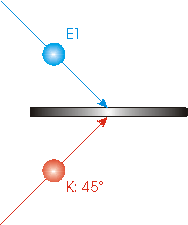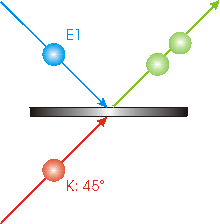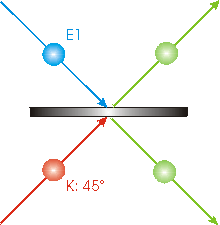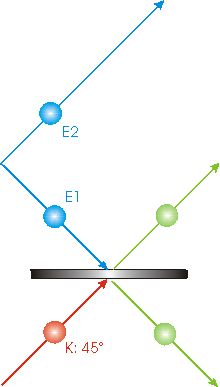Quantum Teleportation, Information and Cryptography
Click here to go to the UPSCALE
home page.
Click here
to go to the Physics Virtual Bookshelf home page.
INTRODUCTION
In March 1993 Charles H. Bennett from IBM proposed a scheme, based on
Quantum Mechanics, that in principle could be used to teleport an object. The
scheme was experimentally verified by Dik Bouwmeester et al. in the Fall of
1997. In 2004 researchers at the University of Vienna and the Austrian Academy of Science used an 800m-long optical fibre fed through a public sewer system tunnel to connect labs on opposite sides of the River Danube to achieve such teleportation..
Here we explore this phenomenon of Quantum Teleportation. We will
then extend the discussion to Quantum Information and Quantum
Cryptography. The document is based on a discussion with an upper year
course in modern Physics without mathematics given at the University of
Toronto.
Although the discussion is almost totally non-mathematical, it requires
considerable understanding of the Quantum Correlation experiments used in
describing Bell's Theorem. A document on Bell's Theorem is available
here;
total file size including graphics is about 47k.
TELEPORTATION
In Star Trek, when Captain Kirk is beamed from the starship
Enterprise to the surface of a planet, Captain Kirk de-materialises on the
Enterprise, and then re-materialises on the planet. On the TV show, an
unanswered question is whether the transporter physically disassembles Captain
Kirk, moves the atoms from his body to the planet, and then reassembles them.
Another perhaps more reasonable alternative would be to scan all the
information about Captain Kirk's physical state, and transmit that information
to the planet surface where it is used to construct a new Captain Kirk out of
raw materials found on the planet. Note that in either case the transporter
needs to have complete information on Kirk's physical state in order to
reconstruct him.
However, the Heisenberg Uncertainty Principle means that it is
impossible to obtain this complete information about Kirk. Thus, it seems that
the best the transporter can do is make an approximate copy of him on the
planet surface. Quantum Teleportation provides a way to "beat" the Uncertainty
Principle and make an exact copy.
As we shall see, the mechanism that beats the Uncertainty Principle is
the same one used to beat it in the Quantum Correlation experiments we examined
when we discussed Bell's Theorem. We shall also see that although the collapse
of the state for the two measurements in the correlation experiments occurs
instantaneously, the teleportation can not occur faster than the speed of
light.
Finally, a little terminology. Before we were discussing Quantum
Correlation experiments in which we were measuring the spins of two separate
electrons whose total spin was zero. We call the states of those two electrons
entangled.
BELL-STATE MEASUREMENTS
In previous discussions we almost always talked about the spin state of
electrons, although we regularly pointed out that the same situations exist for
the polarization of light, albeit with a difference of a factor of 2 in the
angles being used. Here we will reverse the situation, and mostly talk about
polarization states for photons, although the arguments also apply to spin
states of electrons.
The fact that we may talk about light polarization in almost the same
way that we discuss electron spin is not a coincidence. It turns out that
photons have spins which can exist in only two different states. And those
different spins states are related to the polarization of the light when we
think of it as a wave.
Here we shall prepare pairs of entangled photons with opposite
polarizations; we shall call them E1 and
E2. The entanglement means that if we
measure a beam of, say, E1 photons with a
polarizer, one-half of the incident photons will pass the filter, regardless of
the orientation of the polarizer. Whether a particular photon will pass the
filter is random. However, if we measure its companion E2 photon with a polarizer oriented at 90 degrees
relative to the first, then if E1 passes
its filter E2 will also pass its filter.
Similarly if E1 does not pass its filter
its companion E2 will not.
Earlier we discussed the Michelson-Morley experiment, and later the
Mach-Zehnder interferometer. You will recall that for both of these we had
half-silvered mirrors, which reflect one-half of the light incident on them and
transmit the other half without reflection. These mirrors are sometimes called
beam splitters because they split a light beam into two equal parts.
We shall use a half-silvered mirror to perform Bell State
Measurements. The name is after the originator of Bell's Theorem.
|
We direct one of the entangled photons, say E1, to the beam splitter.
Meanwhile, we prepare another photon with a polarization of
450, and direct it to the same beam splitter from the other side, as
shown. This is the photon whose properties will be transported; we label it
K (for Kirk). We time it so that both
E1 and K reach the beam splitter at the same time. |
 |
|
|
The E1 photon incident from
above will be reflected by the beam splitter some of the time and will be
transmitted some of the time. Similarly for the K photon that is incident from below. So sometimes
both photons will end up going up and to the right as shown.
Similarly, sometimes both photons will end up going down
and to the right. |
 |
|
|
But sometimes one photon will end up going upwards and the other
will be going downwards, as shown. This will occur when either both photons
have been reflected or both photons have been transmitted.
Thus there are three possible arrangements for the photons from
the beam splitter: both upwards, both downwards, or one upwards and one
downwards.
Which of these three possibilities has occurred can be determined
if we put detectors in the paths of the photons after they have left the beam
splitter.
However, in the case of one photon going upwards and the other
going downwards, we can not tell which is which. Perhaps both photons were
reflected by the beam splitter, but perhaps both were transmitted.
This means that the two photons have become entangled.
If we have a large beam of identically prepared photon pairs
incident on the beam splitter, the case of one photon ending up going upwards
and the other downwards occurs, perhaps surprisingly, 25% of the time. |
 |
Also somewhat surprisingly, for a single pair of photons incident on the
beam splitter, the photon E1 has now
collapsed into a state where its polarization is -450, the opposite
polarization of the prepared 450 one. This is because the photons
have become entangled. So although we don't know which photon is which, we know
the polarizations of both of them.
The explanation of these two somewhat surprising results is beyond the
level of this discussion, but can be explained by the phase shifts the
light experiences when reflected, the mixture of polarization states of
E1, and the consequent interference
between the two photons.
THE TELEPORTER
|
Now we shall think about the E2 companion to E1.
25 percent of the time, the Bell-state measurement resulted in the
circumstance shown, and in these cases we have collapsed the state of the
E1 photon into a state where its
polarization is -450.
But since the two photon system E1
and E2 was prepared with opposite polarizations,
this means that the companion to E1, E2, now has a polarization of +450. Thus
the state of the K photon has now been
transferred to the E2 photon. We have
teleported the information about the K
photon to E2.
Although this collapse of E2
into a 450 polarization state occurs instantaneously, we haven't
achieved teleportation until we communicate that the Bell-state measurement has
yielded the result shown. Thus the teleportation does not occur
instantaneously.
Note that the teleportation has destroyed the state of the
original K photon.
Quantum entanglements such as exist between E1 and E2 in principle are
independent of how far apart the two photons become. This has been
experimentally verified for distances as large as 10km. Thus, the Quantum
Teleportation is similarly independent of the distance. |
 |
The Original State of the Teleported Photon Must Be Destroyed
Above we saw that the K photon's state was destroyed
when the E2 photon acquired it. Consider for a
moment that this was not the case, so we end up with two photons with identical
polarization states. Then we could measure the polarization of one of the photons
at, say, 450 and the other photon at 22.50. Then we would
know the polarization state of both photons for both of those angles.
As we saw in our discussion of Bell's Theorem, the Heisenberg Uncertainty Principle
says that this is impossible: we can never know the polarization of a photon
for these two angles. Thus any teleporter must destroy the state of the object
being teleported.
OTHER APPLICATIONS
Teleporting the polarization state of a single photon a quarter of the
time is a long long way from reliably teleporting Captain Kirk. However, there
are other applications of the above sort of apparatus that may be closer to
being useful.
Quantum Information
As you probably know, computers store information as sequences of
0's and 1's. For example, in the ASCII encoding the letter
A is represented by the number 65. As a binary number this is:
1,000,001
Inside the computer, there are transistors that are either on or off,
and we assign the on-state be 1 and the off state 0. However, the
same information can be stored in exactly the same way in any system that has
two mutually exclusive binary states.
For example, if we have a collection photons we could represent the
1's as photons whose polarization is +450 and the 0's
as polarizations of -450. We could similarly use electrons with
spin-up and spin-down states to encode the information. These quantum bits of
information are called qubits.
Above we were thinking about an apparatus to do Quantum Teleportation.
Now we see that we can think of the same apparatus as transferring Quantum
Information. Note that, as opposed to, say, a fax, when transferring Quantum
Information the original, the polarization of the K photon, is destroyed.
Quantum Cryptography
Cryptography depends on both the sender and receiver of the encrypted
information both knowing a key. The sender uses the key to encrypt the
information and the receiver uses the same key to decrypt it.
The key can be something very simple, such as both parties knowing that
each letter has been shifted up by 13 places, with letters above the thirteenth
in the alphabet rotated to the beginning. Or they can be very complex, such as
a very very long string of binary digits.
Here is an example of using binary numbers to encrypt and decrypt a
message, in this case the letter A, which we have seen is
1,000,001 in a binary ASCII encoding. We shall use as the key the
number 23, which in binary is 0,010,111. We will use the key to encode
the letter using a rule that if the corresponding bits of the letter and key
are the same, the result is a 1, and otherwise a 0.
| A |
1 |
0 |
0 |
0 |
0 |
0 |
1 |
| Key |
0 |
0 |
1 |
0 |
1 |
1 |
1 |
| Encrypted |
0 |
1 |
0 |
1 |
0 |
0 |
1 |
The encrypted value is 41, which in ASCII is the right parenthesis:
)
To decrypt the message we use the key and the same procedure:
| Encrypted |
0 |
1 |
0 |
1 |
0 |
0 |
1 |
| Key |
0 |
0 |
1 |
0 |
1 |
1 |
1 |
| A |
1 |
0 |
0 |
0 |
0 |
0 |
1 |
Any classical encryption scheme is vulnerable on two counts:
- If the "bad guys" get hold of the key they too can decrypt the
message. So-called public key encryptation schemes reveals on an open
channel a long string of binary digits which must be converted to the key by
means of a secret procedure; here security is based on the computational
complexity of "cracking" the secret procedure.
- Because there are patterns in all messages, such as the fact that the
letter e predominates, then if multiple messages are intercepted using
the same key the bad guys can begin to decipher them.
To be really secure, then, there must be a unique secret key for each
message. So the question becomes how can we generate a unique key and be sure
that the bad guys don't know what it is.
To send a key in Quantum Cryptography, simply send photons in one
of four polarizations: -45, 0, 45, or 90 degrees. As you know, the receiver can
measure, say, whether or not a photon is polarized at 90 degrees and if it is
not then be sure than it was polarized at 0 degrees. Similarly the receiver can
measure whether a photon was polarized at 45 degrees, and if it is not then it
is surely polarized at -45 degrees. However the receiver can not measure both
the 0 degree state and 45 degree state, since the first measurement destroys
the information of the second one, regardless of which one is performed
first.
The receiver measures the incoming photons, randomly choosing whether to
measure at 90 degrees or 45 degrees, and records the results but keeps them
secret. The receiver contacts the sender and tells her on an open channel which
type of measurement was done for each, without revealing the result. The sender
tells the receiver which of the measurements were of the correct type. Both the
sender and receiver keep only the qubits that were measured correctly, and they
have now formed the key.
If the bad guys intercept the transmission of photons, measure their
polarizations, and then send them on to the receiver, they will inevitably
introduce errors because they don't know which polarization measurement to
perform. The two legitimate users of the quantum channel test for eavesdropping
by revealing a random subset of the key bits and checking the error rate on an
open channel. Although they cannot prevent eavesdropping, they will never be
fooled by an eavesdropper because any, however subtle and sophisticated, effort
to tap the channel will be detected. Whenever they are not happy with the
security of the channel they can try to set up the key distribution again.
By February 2000 a working Quantum Cryptography system using the above
scheme achieved the admittedly modest rates of 10 bits per second over a 30 cm
length.
There is another method of Quantum Cryptography which uses entangled photons.
A sequence of correlated particle pairs is generated, with one member of each
pair being detected by each party (for example, a pair of photons whose polarisations
are measured by the parties). An eavesdropper on this communication would have
to detect a particle to read the signal, and retransmit it in order for his
presence to remain unknown. However, the act of detection of one particle of
a pair destroys its quantum correlation with the other, and the two parties
can easily verify whether this has been done, without revealing the results
of their own measurements, by communication over an open channel.
AUTHOR
This document was written in March 2001 by David M. Harrison, Dept. of Physics,
Univ. of Toronto, mailto:harrison@physics.utoronto.ca.
This is $Revision: 1.3 $, $Date: 2004/08/31 11:52:45 $ (year/month/day UTC).
The document and images are Copyright © 2001 - 2004 David M. Harrison




